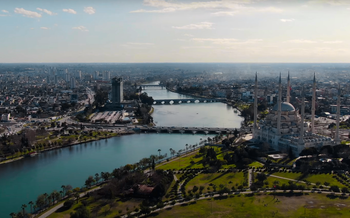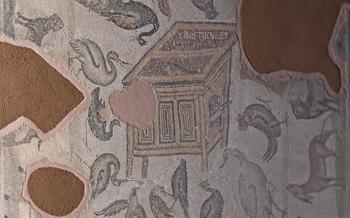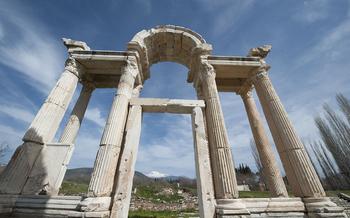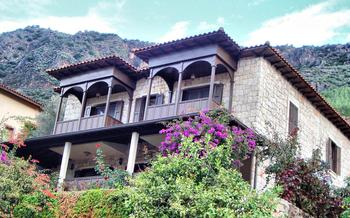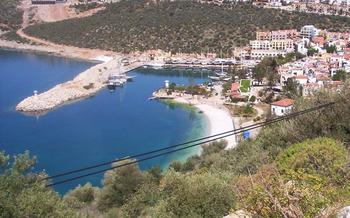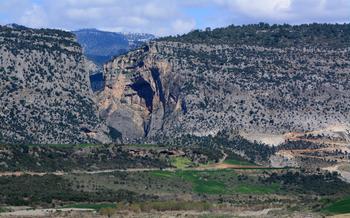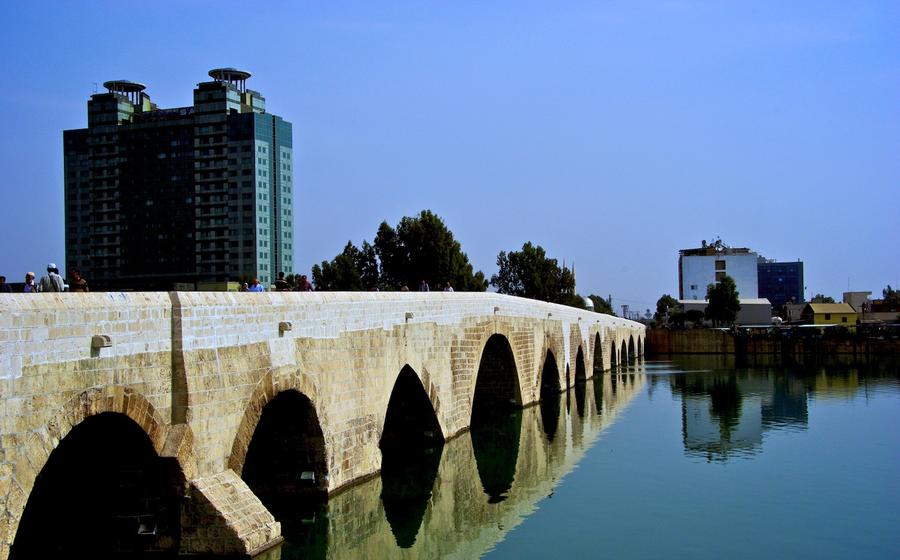
Ancient City of Magarsos
- The Antiquity of Magarsos
- Location and Accessibility
- Exploring the Ruins
- Mosaics and Artwork
- The Hellenistic Theater
- Temple of Zeus Olbios
- The Necropolis
- The Agora
- The City Walls
- The Roman Baths
- The Museum of Magarsos
- Local Cuisine and Delicacies
- Cultural Activities and Festivals
- Exploring the Region
- Insider Tip
The Antiquity of Magarsos
Magarsos, an ancient city with a rich historical tapestry, dates back to the Hellenistic period in the 4th century BC, when it was founded by Alexander the Great's successor, Seleucus I Nicator. According to legend, Magarsos was named after Magarsus, a companion of Alexander the Great, who fell in love with a local woman and decided to settle in the region. Over the centuries, the city flourished as a crucial trade hub due to its strategic location on the Ceyhan River, connecting the Mediterranean Sea with the hinterlands of Anatolia.
Magarsos' archaeological significance lies in its well-preserved ruins, which have attracted extensive excavations and research. These excavations have unearthed remarkable artifacts, shedding light on the city's vibrant past. The discovery of intricate mosaics, monumental structures, and inscriptions has provided valuable insights into the daily lives, cultural practices, and artistic achievements of the ancient inhabitants of Magarsos. Preserving and protecting this exceptional heritage is of utmost importance to safeguard the legacy of this ancient city and ensure its accessibility for future generations.
Location and Accessibility
Magarsos, an ancient city of great historical significance, is situated in the vibrant city of Adana, Turkey. Located in the fertile Çukurova region, Adana is easily accessible by various transportation means.
To reach Magarsos, visitors can take advantage of the well-connected transportation network. Adana Şakirpaşa Airport (ADA), located approximately 5 kilometers from the city center, offers domestic and international flights, making it a convenient option for those arriving by air.
Once in Adana, exploring the ancient city of Magarsos is a breeze. Local transportation options, such as buses and taxis, provide easy access to the site. Visitors can hop on bus lines 133 or 172, which conveniently stop near the entrance of Magarsos. Taxis are also readily available, offering a comfortable and direct ride to the ancient city.
When planning a visit to Magarsos, it's advisable to allocate sufficient time to fully immerse oneself in the history and beauty of the site. A half-day or full-day itinerary is recommended to explore the ruins, admire the mosaics, and delve into the stories and legends associated with this ancient city.
The archaeological site of Magarsos is open to the public daily, with specific operating hours that may vary depending on the season. Entry fees are typically reasonable, allowing visitors to experience the wonders of Magarsos at an affordable cost.
Exploring the Ruins
Strolling through the ancient city of Magarsos is like stepping back in time. Its well-preserved ruins offer a glimpse into the grandeur and sophistication of this once-thriving metropolis. Among the most notable landmarks is the impressive Hellenistic Theater, with its tiered seating and remarkable acoustics. The Temple of Zeus Olbios, dedicated to the king of the gods, stands as a testament to the religious devotion of the city's inhabitants. The agora, once a bustling marketplace and social hub, invites visitors to imagine the vibrant commerce and lively interactions that took place within its walls.
The city walls, with their imposing gates and towers, speak to the strategic importance of Magarsos as a fortified settlement. The necropolis, located just outside the city limits, provides insights into the funerary customs and beliefs of its ancient residents. Intricate mosaics depicting mythological scenes and everyday life adorn the floors of many buildings, offering a glimpse into the artistic prowess of Magarsos' craftsmen.
Exploring the ruins of Magarsos is a journey through history, where each stone and artifact tells a story of a bygone era. Visitors can wander through the ancient streets, marveling at the architectural wonders and imagining the lives of those who once called this city home.
Mosaics and Artwork
Magarsos is home to a collection of exquisite mosaics that offer a glimpse into the artistic prowess and cultural heritage of its ancient inhabitants. These intricate artworks, discovered during archaeological excavations, depict mythological scenes, everyday life, and religious rituals. Created using colorful tesserae, the mosaics showcase the technical skill and creativity of the artisans who crafted them.
The mosaics of Magarsos are particularly notable for their vivid colors and detailed compositions. They feature a variety of subjects, including scenes from Greek mythology, such as the labors of Hercules and the battle between the gods and the giants. Other mosaics depict everyday activities, such as hunting, fishing, and farming.
One of the most impressive mosaics is located in the House of the Mosaics, a well-preserved residential building. This mosaic depicts a Dionysian procession, with the god Dionysus riding in a chariot pulled by satyrs and maenads. The mosaic is remarkable for its intricate details and the vibrant colors used to create the figures.
The mosaics of Magarsos provide valuable insights into the cultural and religious beliefs of the ancient inhabitants of the city. They offer a glimpse into their daily lives, their mythology, and their artistic traditions. The preservation and restoration of these mosaics are essential for ensuring that future generations can continue to appreciate and learn from this rich cultural heritage.
The Hellenistic Theater
Amidst the ruins of Magarsos, the Hellenistic Theater stands as an architectural marvel, a testament to the city's rich cultural heritage. Constructed during the Hellenistic period, likely around the 2nd century BC, this theater served as a venue for theatrical performances, musical concerts, and other forms of entertainment.
With a seating capacity estimated to accommodate thousands of spectators, the theater boasts an impressive design that showcases the architectural prowess of the ancient Greeks. Its semi-circular auditorium, meticulously carved into the natural slope of the hill, ensures optimal acoustics, allowing the performers' voices to resonate throughout the theater.
The stage, adorned with intricate reliefs and sculptures, provides a dramatic backdrop for performances. The elaborate stage building, known as the skene, features three doors through which actors would make their entrances and exits, adding depth and dimension to the theatrical experience.
Beyond its function as a performance space, the theater held significant cultural and social importance in Magarsos. It served as a gathering place for the community, fostering a sense of unity and shared cultural experiences. Whether it was a tragedy, a comedy, or a musical performance, the theater offered an escape from daily life, allowing the audience to immerse themselves in the realm of art and imagination.
Today, the theater stands as a reminder of Magarsos' vibrant cultural scene and its enduring legacy as a center of artistic expression. Although partially restored, it retains its original charm and grandeur, inviting visitors to step back in time and experience the magic of ancient theater.
Temple of Zeus Olbios
Among the notable structures within Magarsos, the Temple of Zeus Olbios holds a significant place. Dedicated to Zeus, the king of the gods in Greek mythology, this temple was a prominent religious center in ancient times. Zeus Olbios, whose name translates to "Zeus the Blessed" or "Zeus of the Mountain," was particularly associated with Mount Olympus, the mythical abode of the gods.
The architectural features of the temple reflect the grandeur and importance of Zeus. Built in the classical Greek style, the temple showcased intricate details and harmonious proportions. Columns with finely carved capitals supported the structure, adding an air of elegance and majesty. Inside the temple, a colossal statue of Zeus Olbios once stood, commanding the attention of worshippers and visitors alike.
Rituals and ceremonies dedicated to Zeus were held within the temple, honoring the deity and seeking his favor. Devotees would offer sacrifices, prayers, and libations to Zeus, seeking blessings, protection, and guidance. The temple served as a focal point for religious observances and played a crucial role in the spiritual life of the Magarsos community.
Understanding the Temple of Zeus Olbios provides valuable insights into the religious beliefs and practices of the ancient inhabitants of Magarsos. It sheds light on the significance of Zeus in the Greek pantheon and his association with Mount Olympus. Furthermore, the temple's architectural features and design offer a glimpse into the artistic and cultural expressions of the time.
The Necropolis
Nestled beyond the bustling streets of ancient Magarsos lies the necropolis, a silent city of the dead that holds countless secrets of the past. Scattered across the arid landscape, these tombs offer a glimpse into the funerary customs and beliefs of the ancient inhabitants.
Excavations have revealed a variety of tombs, ranging from simple rock-cut chambers to elaborate structures adorned with intricate carvings and inscriptions. Each tomb tells a unique story, providing insights into the social status, wealth, and religious beliefs of the deceased.
Among the most notable tombs is the Tomb of the Painted Ceilings, which features vibrant frescoes depicting scenes from mythology and daily life. The Sarcophagus of the Weeping Women is another masterpiece, showcasing the exquisite craftsmanship and artistry of the ancient Magarsians.
These tombs not only served as final resting places but also as repositories of valuable artifacts. Jewelry, pottery, weapons, and other personal belongings were often buried alongside the deceased, offering clues to their social status and daily lives.
The necropolis of Magarsos is a poignant reminder of the mortality of human existence and the enduring legacy of those who came before us. As we wander among these ancient tombs, we cannot help but feel a sense of awe and wonder at the lives that once thrived within the walls of this ancient city.
The Agora
The agora, the bustling heart of ancient Magarsos, served as a vibrant marketplace and a central gathering place for the city's inhabitants. This lively hub of activity was not merely a place of commerce but also a focal point for social interactions, political discourse, and cultural exchange.
The agora's architectural design reflected its multifaceted role. Surrounded by colonnaded walkways that provided shelter from the sun and rain, the open space was dominated by rows of shops and stalls where merchants displayed their wares. These stalls sold a variety of goods, from fresh produce and handcrafted pottery to imported textiles and exotic spices, catering to the diverse needs of the city's population.
Beyond its commercial function, the agora held profound social and political significance. It was here that citizens gathered to discuss matters of governance, exchange news, and engage in lively debates. Orators and philosophers often took to the agora's podium to share their ideas and sway public opinion. The agora, therefore, served as a platform for civic engagement and the formation of public opinion, reflecting the democratic ideals that underpinned ancient Greek society.
As the sun began to set, the agora transformed into a vibrant social hub. Street performers entertained the crowds with music, dance, and acrobatic feats, while food vendors offered a tempting array of local delicacies. The air filled with the sounds of laughter, chatter, and the clinking of glasses as friends and neighbors gathered to relax and unwind after a long day.
Today, the agora of Magarsos stands as a testament to the vibrant urban life that once thrived within the ancient city. Its well-preserved ruins, including remnants of shops, colonnades, and public fountains, offer a glimpse into the bustling commercial and social activities that took place in this central gathering place. Visitors can wander through the agora, imagining the lively atmosphere and the diverse characters that once frequented this bustling hub of ancient Magarsos.
The City Walls
The city walls of Magarsos stand as a testament to the strategic importance of the ancient city. Constructed using local stone and featuring a combination of curtain walls, towers, and gates, these fortifications played a crucial role in defending the city from invaders. The walls were designed to withstand attacks from both land and sea, ensuring the security and prosperity of Magarsos.
The main gate, known as the Cilician Gate, was strategically positioned to control access to the city from the west. This imposing gate featured a double archway and was flanked by two massive towers, providing a formidable defense against potential attackers.
Along the walls, numerous towers were strategically placed to provide surveillance and defensive capabilities. These towers allowed the defenders to monitor the surrounding landscape, spot approaching enemies, and launch counterattacks. The walls also featured several smaller gates, which were used for everyday access and egress.
Today, the city walls of Magarsos are a well-preserved reminder of the city's rich history. Visitors can explore the remains of the walls and towers, marveling at their architectural prowess and imagining the fierce battles that took place here centuries ago. The walls stand as a symbol of the resilience and determination of the ancient people of Magarsos, who relied on these fortifications to protect their homes and way of life.
The Roman Baths
In the heart of ancient Magarsos, nestled amidst the ruins, lies a testament to the Romans' love for bathing rituals and social interactions – the Roman Baths. These well-preserved structures offer a glimpse into the daily lives and cultural practices of the city's inhabitants.
The baths, built with meticulous attention to detail, featured a series of interconnected pools, changing rooms, and heating systems that ensured a luxurious bathing experience. The pools, ranging from hot to cold, allowed bathers to indulge in a rejuvenating cycle of cleansing and relaxation.
Beyond their practical purpose, the Roman Baths served as significant social hubs. Here, people from all walks of life gathered to socialize, exchange news, and engage in philosophical discussions. The baths provided a space for networking, entertainment, and a sense of community.
Today, the Roman Baths stand as a reminder of the Romans' advanced engineering and architectural prowess. Their intricate designs and sophisticated heating systems continue to captivate visitors, offering a glimpse into the grandeur and opulence of ancient Roman society.
Although partially restored, the baths remain an ongoing project, with archaeologists working diligently to uncover and preserve their hidden treasures. Visitors can marvel at the intricate mosaics that adorn the floors and walls, depicting scenes from mythology and everyday life, offering a glimpse into the artistic sensibilities of the time.
As you explore the Roman Baths, imagine the bustling atmosphere that once filled these spaces. Picture bathers clad in togas, engaging in lively conversations, while others sought solace in the soothing waters or indulged in revitalizing massages. The baths were not merely places of hygiene but also centers of social interaction and cultural exchange.
Preserving and restoring the Roman Baths is of utmost importance to safeguard this valuable heritage for future generations. By protecting these ancient structures, we not only honor the legacy of the past but also ensure that this unique glimpse into Roman culture remains accessible to all.
The Museum of Magarsos
The Museum of Magarsos stands as a testament to the city's rich history and cultural legacy. Situated in the heart of Adana, this museum houses a diverse collection of artifacts excavated from the ancient city. As you step through its doors, you embark on a journey through time, discovering the stories and secrets of Magarsos' past.
The museum's exhibits are a treasure trove of archaeological wonders, meticulously preserved and displayed to showcase the artistry and craftsmanship of the ancient inhabitants. From delicate pottery and intricate jewelry to awe-inspiring sculptures and stunning mosaics, each artifact tells a tale of the city's vibrant past.
Through these artifacts, you gain insights into the daily lives of the people of Magarsos. You learn about their religious beliefs, their economic activities, and their social customs. The museum's curators have skillfully arranged the exhibits to create a narrative that brings the ancient city to life.
The Museum of Magarsos is not just a repository of artifacts; it is a place of learning and cultural exchange. Educational programs and exhibitions are regularly organized to promote awareness of the city's heritage. Visitors can engage with experts, participate in workshops, and delve deeper into the fascinating world of Magarsos.
A visit to the Museum of Magarsos is a must for anyone interested in history, archaeology, and the rich cultural tapestry of Turkey. It is a place where the past comes alive, inviting you to explore the depths of an ancient civilization and marvel at the wonders it has left behind.
Local Cuisine and Delicacies
Adana's cuisine is a symphony of flavors, a culinary journey that tantalizes the taste buds and leaves a lasting impression. Among the must-try dishes is the legendary Adana kebab, a succulent skewer of minced lamb grilled to perfection, served with grilled vegetables and tangy sauce. Şırdan, a delicacy made from lamb intestines stuffed with rice, spices, and herbs, is a unique and flavorful experience. And for a sweet ending, künefe, a crispy pastry filled with melted cheese and topped with shredded filo dough and sweet syrup, is an absolute delight.
To savor the authentic flavors of Adana, venture into the city's vibrant local markets, where vendors display an array of fresh produce, spices, and traditional delicacies. Here, you'll find hidden culinary gems, such as freshly baked gözleme, a savory flatbread filled with various ingredients, or keşkek, a hearty dish made from pounded wheat, meat, and yogurt.
For a memorable dining experience, visit one of Adana's many traditional restaurants, where you can indulge in a feast of local specialties. Be sure to try the region's famous meze platter, a selection of small dishes that showcase the diverse flavors of Adana's cuisine.
As you explore the culinary delights of Adana, remember to embrace the local customs and etiquette. Show respect for the local culture by dressing modestly and behaving politely. And when in doubt, don't hesitate to ask for recommendations or guidance from the friendly locals, who are always eager to share their culinary traditions with visitors.
Cultural Activities and Festivals
Adana is a vibrant city that proudly embraces its rich cultural heritage. Throughout the year, a variety of festivals and events showcase the city's unique traditions, music, dance, and handicrafts. These celebrations offer visitors an immersive experience, allowing them to connect with the local culture and gain a deeper understanding of Adana's identity.
One of the most prominent festivals is the Adana kebab festival, a culinary extravaganza dedicated to the city's signature dish. This festival attracts food enthusiasts from across the region, who come to savor the mouthwatering flavors of Adana kebab, prepared by skilled chefs using traditional techniques. The festival also features live music, dance performances, and cultural exhibitions, creating a lively and festive atmosphere.
Another highlight is the Adana International Film Festival, which screens a diverse selection of films from around the world. This festival provides a platform for local and international filmmakers to showcase their work, fostering cultural exchange and appreciation for the art of cinema.
For those interested in traditional crafts, the Adana Handicrafts Fair is a must-visit. Here, artisans from the region display their exquisite handmade creations, including intricate pottery, vibrant textiles, and delicate jewelry. Visitors can admire the skill and artistry of these talented craftsmen and women, and purchase unique souvenirs to cherish as reminders of their time in Adana.
Don't miss the opportunity to immerse yourself in the vibrant cultural scene of Adana and partake in its lively festivals and events. Engage with the friendly locals, learn about their customs and traditions, and create lasting memories that will transport you back to the heart of this captivating city.
Exploring the Region
Beyond the ancient city of Magarsos, the region offers a wealth of attractions that invite further exploration. History buffs can delve into the past at the nearby archaeological sites of Anavarza and Karatepe, uncovering the remnants of ancient civilizations that once thrived in this region. Nature enthusiasts can embark on a scenic journey to the breathtaking Karacaören Waterfall, surrounded by lush greenery and cascading waters.
For those seeking a unique cultural experience, a visit to the traditional village of Hacıpaşa is a must. Here, visitors can witness the vibrant local lifestyle, savor authentic cuisine, and immerse themselves in the rich handicrafts and folklore of the region.
History, nature, and culture intertwine harmoniously in this region, promising an unforgettable journey for every traveler. Plan your itinerary wisely to make the most of your visit and discover the hidden gems that await you beyond the walls of Magarsos.
Insider Tip
Strolling through the ancient ruins of Magarsos, you may stumble upon hidden gems that offer unique perspectives of this historical site. One such gem is the Temple of Apollo, nestled amidst the ruins, slightly off the beaten path. While smaller in size compared to the Temple of Zeus Olbios, it exudes a serene and mystical aura. Take a moment to admire its intricate carvings and imagine the rituals that once took place within its walls.
To capture stunning photographs, visit Magarsos during the golden hour, just before sunset. The warm, diffused light casts a magical glow on the ancient stones, creating an ethereal atmosphere. Avoid visiting during peak tourist hours, typically in the mid-afternoon, to enjoy a more tranquil and intimate experience.
Remember to be respectful of the site's historical significance. Refrain from touching or climbing on the ruins, as this can damage the delicate structures. Follow designated paths and adhere to conservation guidelines to ensure the preservation of Magarsos for future generations.



